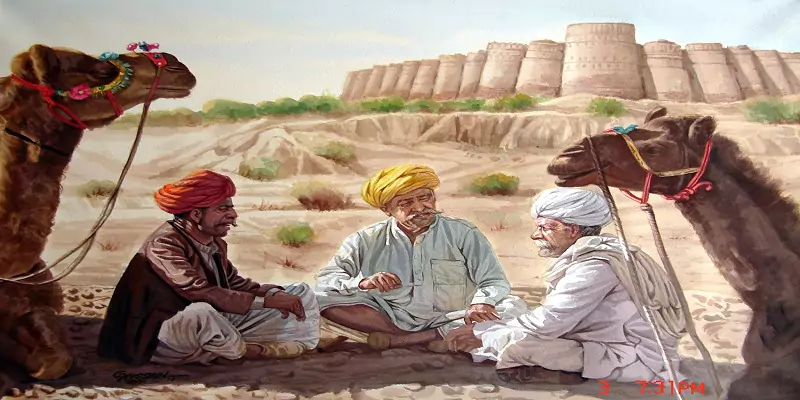Saraiki culture
Saraiki culture, deeply rooted in the heartland of Pakistan, is a rich tapestry woven with the threads of history, tradition, and a vibrant way of life. Encompassing a diverse range of customs, arts, music, and cuisine, Saraiki culture reflects the unique identity of the Saraiki-speaking people who predominantly inhabit the southern regions of Punjab, including Multan, Bahawalpur, Dera Ghazi Khan, and the surrounding areas.
At the core of Saraiki culture is the Saraiki language, a distinct Indo-Aryan language with its own phonology, grammar, and vocabulary. The language serves as a powerful medium for expressing the cultural nuances and heritage of the Saraiki people. Urdu and Punjabi also play significant roles in communication, but Saraiki remains the soul of local expression.
Saraiki literature, though not as widely recognized as some other regional literary traditions in Pakistan, has a rich heritage. Poets like Khwaja Ghulam Farid, Sachal Sarmast, and Khwaja Fareed have left an indelible mark on Saraiki poetry. Their verses often delve into themes of love, mysticism, and the beauty of the rural landscapes, resonating with the ethos of the local populace.
Saraiki attire reflects the essence of the region's agrarian lifestyle. For men, the traditional dress consists of a kurta, shalwar, and a turban or cap. The kurta is often adorned with intricate embroidery, showcasing the artisanal skills of the local craftsmen. Women typically wear colorful dresses with vibrant patterns, complemented by traditional jewelry, including nose rings, bangles, and earrings.
Saraiki music is characterized by its soulful melodies and profound lyrics, often depicting the tales of love, separation, and the rustic life. The region has produced renowned folk artists like Attaullah Khan Esakhelvi, Shafaullah Khan Rokhri, and Abida Parveen, who have played a pivotal role in promoting Saraiki music on both national and international platforms.
The dhamaal, a lively and energetic dance, is an integral part of Saraiki culture. Accompanied by the beats of the dhol, the dance is a manifestation of jubilation during cultural festivals, weddings, and other celebratory occasions. The swirling movements of the dancers encapsulate the vitality and exuberance of Saraiki traditions.
Saraiki cuisine is a delightful blend of flavors, showcasing the agricultural abundance of the region. Wheat-based dishes like roti, paratha, and naan are staples, often accompanied by a variety of lentils, vegetables, and meats. Saag (cooked mustard greens) and Makki di Roti (cornbread) are popular winter delicacies, providing warmth and nourishment during the colder months.
The region is also known for its delectable sweets, with Multan being particularly famous for Sohan Halwa and other traditional desserts. These sweet treats are often exchanged during festivals and joyous occasions, symbolizing the spirit of communal sharing and celebration.
Saraiki culture is marked by a multitude of festivals and celebrations, each reflecting the cultural and religious diversity of the region. Eid ul-Fitr and Eid ul-Adha are celebrated with great fervor, bringing communities together for prayers, feasts, and the exchange of gifts. The Urs (anniversary celebrations) of Sufi saints, such as those of Bahauddin Zakariya in Multan, are significant religious and cultural events, drawing devotees from across the country.
Basant, the festival of kites, holds a special place in Saraiki culture. Colorful kites fill the skies as people engage in friendly competitions, showcasing their kite-flying skills. The festival marks the arrival of spring and is a time of joyous celebration, with families and friends coming together for picnics and outdoor activities.
Saraiki culture is deeply intertwined with the agrarian lifestyle of its people. The vast, fertile plains of the region are dotted with fields of wheat, cotton, and sugarcane, sustaining the local economy. The traditional village setup, with its mud-brick houses and narrow winding lanes, reflects the simplicity and resilience of rural life.
Agricultural festivals, such as the harvest festival of Baisakhi, are celebrated with great enthusiasm. These events are an occasion for farmers to express gratitude for a bountiful harvest, with rituals, music, and dance playing a central role in the festivities.
Despite the richness of Saraiki culture, there are challenges to its preservation and promotion. The dominance of mainstream Urdu and Punjabi cultures has sometimes overshadowed Saraiki identity. Efforts are underway to promote Saraiki language and literature, with educational initiatives and cultural programs aimed at fostering a sense of pride and awareness among the youth.
Saraiki culture is a vibrant and dynamic tapestry that weaves together the threads of language, literature, music, cuisine, and traditions. It is a celebration of the agrarian spirit, the beauty of rural life, and the resilience of a community deeply rooted in its cultural heritage. As efforts to preserve and promote Saraiki culture continue, it is crucial to recognize and appreciate the diversity that contributes to the rich mosaic of Pakistani identity.

